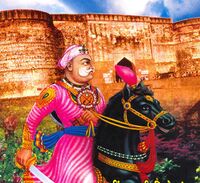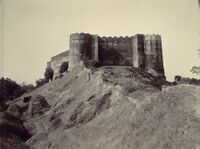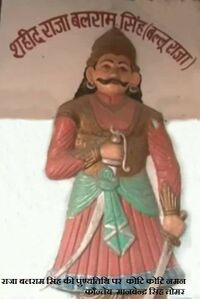History of the Jats:Dr Kanungo/Raja Suraj Mal, An Ally of Nawab Safdar Jang
| Digitized & Wikified by: Laxman Burdak IFS (R) |
By K. R. Qanungo. Edited by Vir Singh. Delhi, Originals, 2003, ISBN 81-7536-299-5.
Chapter IV. Raja Suraj Mal, An Ally of Nawab Safdar Jang
History of Ballabhgarh
[p.45]: Already master of the Mathura district, Suraj Mal cast his eye upon the neighbourhood of Delhi and was waiting for an oportunity to extend his authority further south. The Jats of Ballamgarh, hard pressed by the faujdar of Faridabad, sought his help, and this embroiled him further with the Mughal Government. We may here briefly trace the history of the Jat feudal house of Ballamgarh. One Gopal Singh Jat of the Tewatia got (sept) settled in Sihi, a village three miles north of Ballamgarh, about 1705 and became wealthy and powerful by highway robbery on the Mathura Delhi road. He allied himself with the Gujars of Tiagaon (8 miles east of Ballamgarh; long. 77°-30', lat. 28°-25'. ) and with their help killed the Rajput Chaudhari of the neighbouring villages. Murtaza Khan the local Mughal officer of Faridabad, instead of punishing the rebel, made peace with him by appointing him as Chaudhari of Faridabad pragana, entitled to a cess (rate) of one anna in the rupee on the revenue in 1710. After the death of Gopal Singh, his son Charandas succeeded him. and seeing how weak the imperial grasp was growing even in the nearer districts, withheld the revenue and set the authority of Murtaza Khan at defiance. However, Charandas was captured and thrown into prison at Faridabad. After some time, his son Balaram, duping1 the Khan by a false payment of ransome, set him at
1. The story goes that Balaram promised to pay a large amount; in cash directly his father was freed. According to previous stipulations, Charandas was brought guarded to the side of a tank near Ballamgarh, and when the cart bringing the treasure had come up, Charandas was let go. He immediately made of on a fleet horse with his son. The other bags were found to contain copper coins (paisa) only. Delhi, Gazetteer, foot note, p. 213.
[p.46]: liberty, Father and son fled to Bharatpur, and securing the aid of Suraj Mal, killed Murtaza Khan (Delhi Gazetteer, p. 213).
This act of rebellious aggression remained unpunished till the accession of Emperor Ahmad Shah (1747). The Wazir wrote repeatedly to Balram and Raja Suraj Mal to give up the above mentioned parganas, but was put off with false pretences and evasive replies. This was sufficient to kindle the wrath of the wazir and to make him swear the utter destruction of the Jats. So he took the field against them in 1162 H. (January, 1749), almost simultaneously with the Amir-ul-umra, and captured Faridabad. Suraj Mal, elated with his recent success over one imperial army led by the commander-in-chief of the Mughal empire, was not in a mood to hear the proposals of the wazir to resign peacefully the places in dispute. He prepared to back the Jats of Sihi with all his resources and putting the forts of Deeg and Kumher in a state of defence, marched against the wazir (June, 1749). Fortune befriended Suraj Mal; the wazir, on receiving the news of formidable Ruhela rebellion in the immediate neighbourhood of his suba of Oudh, had to put off the settlement of his score with the Jats and return to Delhi. He fought these Afghans, and after quelling their disturbance, left his deputy Nawal Ray in charge of the districts wrested from them (beginning of 1750). Then he resumed his operations against the Jats, and sent an army against them. The Jats having got ready for fight, the wazir started against them during the rains (July 1750) and advanced as far as Khizirabad. About this time the news of a great disaster, viz., the defeat and death of Nawal Ray at the hands of Ahmad Khan Bangash, induced the wazir to make up his quarrel with Suraj Mal. A compromise was effected through the mediation of the Maratha vakil. In order to save appearences, Balaram.1 with his wrists bound together,
2. This Balaram is the builder of the fort of Ballamgarh or Ballabgarh. He is not the same man as his namesake, who was the brother of Suraj Mal's wife, Hansia. This Balaram was killed on the 29th November, 1753 by one Aqibat Mahmud Khan as appears from the following entry (p. 83) in the Waqa-i-Shah Alam Sani: "On the 2nd Safar (1167 H.) Aqibat Khan, who went to Ballu Jat (Balaram) to settle the affair of his jagir, had an exchange of harsh words with Jat. He cut off the head of the said Jat and brought his head to His Majesty (Ahmad Shah)." This Aquibat Mahmud was the son of Murtaza Khan, whom Balaram had slain. However, Ballamgarh and Faridabad remained in possession of Suraj Mal who appointed Kishan Singh and Bishan Singh, sons of Balaram, as the quiladar and nazim of Ballamgarh. They retained their office till 1774. (See Delhi Gazetter, p. 213) This date, like all others, in the Gazetteer is doubtful.
[p.47]: accompanied the Maratha envoy to the presence of the wazir, who graciously pardoned him and gave an implicit sanction to his illegal acquisitions. Raja Suraj Mal was given a khilat of 6 pieces, and his bakhshi one of two pieces. Mutual appreciation of merit and ability laid the foundations of a true friendship between the Nawab wazir and the great Jat, who ever after stood faithfully by his ally, even under most desperate circumstances.
Battle of Pathari
Raja Suraj Mal joined the wazir in an expedition3 against Ahmad Khan Bangash and the Ruhelas. The Nawab started on the 29th Shaban, 1163 H. = Monday 23 July, 1750 with an army of 70,000 horse. Suraj Mal with his Jats, occupied Farrukhabad, the capital of Ahmad Khan. A severe battle was fought at Pathari on Monday 22nd Shawwal1163 H. (13 Sept. 1750). The wazir stood in the centre, mounted on an elephant; his right and left wings were commanded respectively by Suraj Mal Jat and Ismail Khan Kabuli. Both wings vigourously charged the enemy at a gallop and drove away Rustam Khan Afridi and some other Ruhela commanders, killing 6,000 or 7,000 Afghans. The battle began at nine and raged till the afternoon, the advantage being on the side of Safdar Jang. Ahmad Khan Bangash, seeing all lost, summoned his tribes men and urged them to make a last effort to retrieve their honour; "Otherwise", he said to them in the characteristic Pathan style "every Afridi [their braver comrades] will make water upon the beard of the
3. Waqa, pp. 57-58; Harcharan Das, Imad, 49.
[p.48]: Bangashes."4 The Afghans assembled in a grove of palash trees, and made a sudden rush upon the wazir's party. The wazir had dangerously weakened his division by sending reinforcements to his wings. But he neither pushed forward to keep touch with his commanders nor recalled them from pursuit. Nawab Safdar Jang severely wounded was brought into the camp. Next morning he began his retreat towards the imperial capital. The Afghans occupied almost the whole of his territories; the city of Allahabad was plundered; and its citadel besieged: Lucknow was saved only by the stubborn courage of the citizens. In the meanwhile, when the news of his defeat had reached Delhi, his enemies had turned the heart of the Emperor against him, and were plotting for his overthrow. But his timely arrival disconcerted their plan. The wazir again summoned Raja Nagar Mal, Raja Lachhmi Narayan, Raja Suraj Mal Jat, Ismail Khan Kabuli and others who were his well-wishers, to discuss the plan of a new campaign against the Ruhelas. He took into his pay the Maratha army of Malhar Rao Holkar for Rs. 25,000 per day, and the Jats of Suraj Mal5 on a daily allowance of Rs. 15,000. On the 6th Rabi I., 1164 H. (Tuesday, 22 Jan. 1751) he started a second time against Ahmad Khan Bangash. Farrukhabad was sacked and the wholeRuhela country devastated with fire and sword. A thorn was planted in the side of the Ruhelas to torment them perpetually by giving the tract of country from Koel (Aligarh) to Kora Jahanabad to the Marathas6 as jagir. He sent greetings to the Emperor on his victory over the Afghans on 9th Jamada, II. 1164 H. = April 24, 1751 [Waqa, p. 62]. This shows that this campaign was a short but sharp one, everything being finished within three months.
About a month after the wazir's departure from the capital, a great calamity had befallen the empire. Ahmad
4. Imad, p. 49; Siyar, p. 295. The author of Gulsitan-i-Rahamat says that Rustam Khan Afridi had actually been killed by Suraj Mal, and that Ahmad Khan concealed this from his followers.
5. Ibratnama, p. 41; Bayan-o-Waqa, p. 26; Waqa-i-Shah Alam Sani, p.61.
6. Waqa, p. 62. A good account of the Maratha activity during this campaign is to be found in Sardesai's Marathi Riysat Panipat Prakamn, p. 10-14.
[p.49]: Shah Abdali invaded the Punjab, entered Lahor on the 3rd of Rabi II. 1164 H. = Monday, 18 Feb, 1751 and threatened to march upon Delhi. The Emperor, as a compliment to Suraj Mal conferred a mansab of 3,000 Zat, 2,000 horse, and the title of Rao upon Ratan Singh, and that of 1,000 Zat, 1,000 horse upon Jawahar Singh (13th Jamada 1. = 29 March 1751) in addition to his former rank, making him in all a mansabdar of 4000 Zat, 3500 horse [Waqa, p. 70]. Repeated and urgent messages were sent to the wazir to come with all haste, bringing Malhar Rao Holkar and other Maratha chiefs with him. During the wazir's absence a lady of the harem, an eunuch, and a supple intriguer had acquired complete control over the Emperor's fickle mind. They induced him to accept the terms of the Durrani invader, who consented to retire on getting the subas of Lahor and Multan. On his return to the capital, the wazir justly resented this ignominious treaty made in his absence and without consulting him. He was bent upon punishing the evil-doers. The eunuch was to be the first victim of the wazir's wrath. Javid Khan was invited to a feast in the wazir's house and there murdered.
Suraj Mal saved his ally Nawab Safdar Jang
The Emperor Ahmad Shah, instigated by the queen-mother and the nobles of the Turani faction, dismissed Nawab Safdar Jang, from the office of the wazir, confiscated his estates, and removed him from the viceroyalties of Oudh and Allahabad. A civil war broke out between them; the ex-wazir, stung with the ingratitude of his sovereign, and unwilling to yield to him so tamely, laid siege to the capital and sent for Raja Suraj Mal Jat.XVI The Afghans, the natural enemies of Safdar Jang, joined the imperial army under young Ghazi-ud-din Imad-ul-mulk. The Jats, instigated by the angry Nawab, so thoroughly sacked old Delhi and its neighbourhood that the people still remember it as Jat-gardi7 or Jat loot which takes rank in their memory, with two other classic loots the Shahgardi of Ahmad Shah Abdali, and
XVI. Suraj Mal received most pressing call for help from Wazir Safdarjang at Ghasira. Qanungo does not mention Suraj Mal's ) campaign (Feb 1753 - April 1753) against Bahadur Singh Bargujar of Ghasira. See for detailed description, Sudan, Sujan Charitra, 103-140, 146; for brief account see, Tarikh-i-Ahmad Shahi, 47a. - Ed.
7. Imad, p. 63.
[p.50]: the Bhao-gardi of the Marathas before Panipat. But the Mughals in the service of Safdar Jang deserted him to a man, and joined their Turani brethren under Ghazi-ud-din. His only hope now rested upon Raja Suraj Mal, and the Jat proved no broken reed to him in this hour of supreme need. Promises of high honours and threats of vengeance were treated with equal scorn by that faithful chief, who was determined to fight to the last for his ally, though his was clearly a lost cause. In order to terrify him, Ghazi-ud-din sent for Malhar Rao Holkar from the south. But this was equally unavailing; the clever Jat took advantage of the jealousy of the new wazir Intizam-ud-daula towards his ambitious nephew Ghazi-ud-din, whose motive he suspected and whose ability he dreaded. So successful was the diplomatic move of Suraj Mal that before the Marathas could arrive offers of peace were made from the Emperor's side; Maharaja Madho Singh Kachhwah, who came to Delhi about the end of 1753, was asked to mediate. The Jat Raja refused to sheathe his sword unless the Emperor restored the viceroyalties of Oudh and Allahabad, if not the office of wazir also, to Safdar Jang. At last peace was concluded on the above conditions, and the Nawab departed to rule his suba. Suraj Mal had saved his ally from almost inevitable ruin by drawing upon himself the implacable enemity of Ghazi-ud-din, the full force of which he was made to feel very soon.8
8. For a detailed account of this civil war, see Tarikh-i-Muzaffari, pp. 65-75. Bayan-o-Waqa, pp. 270-280. Harcharan Das also describes this civil war in five pages. The general narrative given in Tarikh-i-Muzaffari is more authentic.
XVII. For a critical account of available sources of this civil war, see, G. C. Dwivedi, The Jats - Their Role in the Mughal Empire, pp. 130 - 137. -Ed.
Note:Images are not part of the original book but have been added in online edition from Jatland Wiki gallery to make content interesting and for better understanding of the text.


